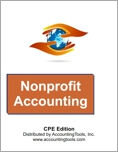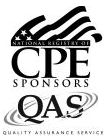Nonprofit Accounting (CPE Course)
CPE Credit: 16 hours
Course Type: Downloaded PDF materials with online test
Price (with PDF Textbook): $110
Course Description
This practical guide shows how to create and operate a nonprofit accounting system and produce financial statements, all while operating in accordance with nonprofit accounting standards. The course walks the accountant through basic nonprofit accounting concepts and then discusses more advanced topics, including budgeting, controls, ratio analysis, revenue recognition, joint costs, split-interest agreements, tax reporting, and mergers and acquisitions. In short, the course offers a wealth of information for understanding nonprofit transactions and financial statements.
Author: Steven Bragg
Course Number: AC1070
Table of Contents
Chapter 1. Overview of the Nonprofit Entity
Chapter 2. Basic Nonprofit Accounting Concepts
Chapter 3. Nonprofit Financial Statements
Chapter 4. Revenue Accounting
Chapter 5. Government Grants
Chapter 6. Investment Accounting
Chapter 7. Inventory Accounting
Chapter 8. Fixed Asset Accounting
Chapter 9. Lease Accounting
Chapter 10. Pension Plan Accounting
Chapter 11. Joint Costs and Allocations
Chapter 12. Accounting Changes and Error Corrections
Chapter 13. Fair Value
Chapter 14. Other Accounting Topics
Chapter 15. Split-Interest Agreements
Chapter 16. Affiliated Organizations
Chapter 17. Mergers and Acquisitions
Chapter 18. Nonprofit Tax Reporting
Chapter 19. Closing the Books
Chapter 20. Nonprofit Budgeting
Chapter 21. Accounting Controls
Chapter 22. Nonprofit Policies
Chapter 23. Analysis of a Nonprofit's Financial Health
Learning Objectives
Cite the criteria used to define a nonprofit organization.
Specify the essential building blocks of an accounting system.
Identify the types of nonprofit financial statements and the comparable for-profit financial statements.
Specify the instances in which revenue and gains can be recognized by a nonprofit.
Cite the methods used to assign costs to a grant-funded program.
State the applicable rules related to the recognition of investment assets.
Identify the costing characteristics of the various cost layering methodologies.
Identify the options available for recognizing a collection.
Recall how the 12-month lease exception works.
Specify the different types of lease payments.
Recognize the components of net periodic pension cost, and the accounting for a defined contribution plan.
Identify the types of joint costs, and the tests used to determine whether fundraising costs can be allocated.
Define the situations in which accounting principles can be changed, and when retrospective application is allowed.
State the concept of the principal market and the basis upon which fair value is determined.
Cite the accounting for a contribution receivable, as well as the steps involved in a petty cash reconciliation.
Identify the accounting associated with split-interest agreements, as well as the nature of lead and remainder interests.
Specify the circumstances under which the reporting consolidation of two or more entities is required or allowed.
Recognize the situations in which the carryover and acquisition methods are used, and whether goodwill or an inherent contribution can be recorded for an acquisition transaction.
State the IRS forms used for various nonprofit tax reporting activities, and the circumstances under which they must be filed.
Cite the steps involved in closing the books at the end of a reporting period.
Identify the line items used in nonprofit budgets and cash forecasts.
Specify the considerations to be reviewed when creating controls, as well as the controls employed in the cash, fixed asset, payables, and other accounting areas.
Recognize the considerations involved in setting policies for collections, asset dispositions, and employee labor.
Cite the types of analysis that can be employed to yield insights into the financial condition and fundraising effectiveness of a nonprofit.
Level: Overview
Instructional Method: QAS Self-Study
NASBA Category: Accounting
Prerequisites: None
Advance Preparation: None
Latest Review Date: March 2024
Program Registration Requirements: Click on "Purchase Course" near the top of this page to pay for and access the course. You will then be able to download the course as a PDF file, then take an on-line examination, and then download a certificate of completion if you pass the examination.
Program Refund Policy: For more information regarding administrative policies concerning complaints, refunds, and other matters, see our policies page.
AccountingTools, Inc. is registered with the National Association of State Boards of Accountancy (NASBA) as a sponsor of continuing professional education on the National Registry of CPE Sponsors. State boards of accountancy have the final authority on the acceptance of individual courses for CPE credit. Complaints regarding registered sponsors may be submitted to the National Registry of CPE Sponsors through its website: www.nasbaregistry.org.
The NASBA sponsor identification number for Accountingtools, Inc. is 115881.
AccountingTools is an IRS Approved Continuing Education Provider. We are compliant with the requirements for continuing education providers (as described in sections 10.6 and 10.9 of the Department of Treasury’s Circular No. 230 and in other IRS guidance, forms, and instructions). Our IRS Approved Continuing Education Provider number is 72821.


